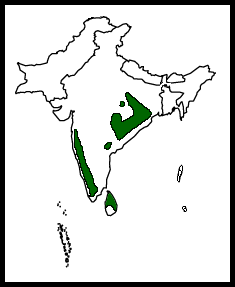m (Image first) |
m (typo) |
||
| Line 18: | Line 18: | ||
| rowspan=2 valign="center"| | | rowspan=2 valign="center"| | ||
[[Image:Map-MalabarPiedHornbill.png|left]] | [[Image:Map-MalabarPiedHornbill.png|left]] | ||
| − | |Endemic to the [[India]]n Subcontinent. Found in the [[Western Ghats]] (SW India), Northern [[Sri Lanka]] and further north (Orissa, Andhra Pradesh, Chhattisgarh, | + | |Endemic to the [[India]]n Subcontinent. Found in the [[Western Ghats]] (SW India), Northern [[Sri Lanka]] and further north (Orissa, Andhra Pradesh, Chhattisgarh, Jharkhand, West Bengal) where it meets with [[Oriental Pied Hornbill]].<br/> |
The population is clearly declining and it has become rare in parts of its range, especially outside National Parks. Habitat loss seems to be the main factor for this. The decline is so severe that the latest field guide lists the entire range in mainland India as hypothetical<sup>[[#References|7]]</sup>. The species therefore seems to be most common in [[Sri Lanka]]. | The population is clearly declining and it has become rare in parts of its range, especially outside National Parks. Habitat loss seems to be the main factor for this. The decline is so severe that the latest field guide lists the entire range in mainland India as hypothetical<sup>[[#References|7]]</sup>. The species therefore seems to be most common in [[Sri Lanka]]. | ||
|- | |- | ||
Revision as of 21:51, 31 December 2012
Alternative name: Indian Pied Hornbill
- Anthracoceros coronatus
Identification
Length 65 cm (25.5 in); a medium-sized Pied Hornbill.
- Black plumage with white belly
- Yellowish-white throat patch, white tail sides and trailing edge to the wings
- Bill pale yellow with black cutting edges and base
- Huge casque with projecting front edge, coloured yellow and black
- Red eyes
- Male has dark blue bare skin around eye, female white with pink tinge
- Juveniles with smaller bill, facial skin duller version of adult's
Similar Species
Confusion is possible with Oriental Pied Hornbill. The ranges of the two species meet in eastern Central India. Oriental Pied is smaller, has smaller casque with less black and the throat patch is bluish.
Distribution
| Endemic to the Indian Subcontinent. Found in the Western Ghats (SW India), Northern Sri Lanka and further north (Orissa, Andhra Pradesh, Chhattisgarh, Jharkhand, West Bengal) where it meets with Oriental Pied Hornbill. The population is clearly declining and it has become rare in parts of its range, especially outside National Parks. Habitat loss seems to be the main factor for this. The decline is so severe that the latest field guide lists the entire range in mainland India as hypothetical7. The species therefore seems to be most common in Sri Lanka. | |
| Legend |
Taxonomy
Forms a superspecies with Oriental Pied Hornbill and Palawan Hornbill. Was long considered to be conspecific with Oriental Pied Hornbill and the two species have been confused several times, leading to synonymy of common and scientific names. The subspecies convexus of Oriental Pied Hornbill has been erroneously placed in this species.5
This is a monotypic species[1],5,6
Habitat
Evergreen forest, tall deciduous forest, also more open patches of forest and plantations. Sometimes seen at fruiting trees well outside forest.
Behaviour
Vocalizations
Calls seems to be loud and quite variable, including both nasal squeals and deeper chucks.
Diet
Feeds mainly on fruits, but takes also leaves and small animals. Feeds mainly among foliage, but also on ground for fallen fruits or to catch small animals and insects.
Breeding
Breeding season from January to April. 2-4 white eggs are laid in a tree hole nest, which is blocked off with a cement made of mud, droppings and fruit pulp. There is only one narrow aperture, just big enough for the male to transfer food to the mother and the chicks.
When the chicks and the female are too big to fit in the nest, the mother breaks out and rebuilds the wall, then both parents feed the chicks.
Generally resident, but some food-related movement occurs.
References
- Rasmussen, PC and JC Anderton. 2005. Birds of South Asia: The Ripley Guide. Barcelona: Lynx Edicions. ISBN 978-8487334672
- Grimmett, R, C Inskipp, and T Inskipp. 1998. Birds of the Indian Subcontinent. London: Christopher Helm. ISBN 978-0713640045
- Kazmierczak, K and B van Perlo. 2000. A Field Guide to the Birds of the Indian Subcontinent. New Haven: Yale Univ. Press. ISBN 978-0300079210
- Kazmierczak, K and R Singh. 2001. A Birdwatcher's Guide to India. New Dehli: India Oxford Univ. Press. ISBN 978-1871104080
- Del Hoyo, J, A Elliot, and J Sargatal, eds. 2001. Handbook of the Birds of the World. Volume 6: Mousebirds to Hornbills. Barcelona: Lynx Edicions. ISBN 978-8487334306
- Clements, J. F., T. S. Schulenberg, M. J. Iliff, B.L. Sullivan, C. L. Wood, and D. Roberson. 2012. The eBird/Clements Checklist of Birds of the World. 6th ed., with updates to October 2012. Ithaca: Cornell Univ. Press. ISBN 978-0801445019. Spreadsheet available at http://www.birds.cornell.edu/clementschecklist/downloadable-clements-checklist
- Grimmett, Inskipp & Inskipp 2012. Birds of India, Pakistan, Nepal, Bangladesh, Bhutan, Sri Lanka, and The Maldives. Princeton Field Guides. ISBN 978-0-691-15349-0
Recommended Citation
- BirdForum Opus contributors. (2024) Malabar Pied Hornbill. In: BirdForum, the forum for wild birds and birding. Retrieved 16 April 2024 from https://www.birdforum.net/opus/Malabar_Pied_Hornbill







